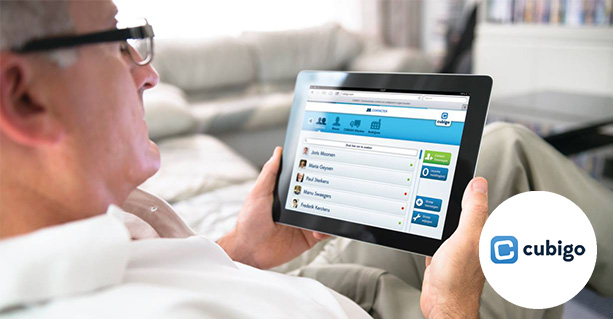Population aging and changing of demographics has always been an obvious problem for several years. For instance, a study by Pew Research Center explains that 59.3 million Americans are expected to be above 65 years of age by 2030. Another research by Eurostat presents the potential aging population development in Europe. Accordingly, the Europe’s senior population is expected to rise to 129.8 million by 2050.
On top of that, there is a mismatch between the expectations of of the seniors and the living situation they are put in. Therefore, with a growing aging population and an un-touched market, Cubigo has been continuously working to digitize the common functions within the senior living communities including: dining, maintenance, transportation, communication and activities.
Cubigo is an all-in-one integrated platform that manages, organizes and facilitates senior housing operations by digitally connecting community staff, residents and family members to improve workflows, lower operating costs and digitize the processes.
What is the market challenge?
The biggest challenge is that, often, some residents are forced into nursing homes for fractured bones, or they have lost their loved ones and are now living by themselves. Thus, our seniors feel that moving into an assisted home is a downgrade to their life.
How do you solve that challenge?
Cubigo is a software company that integrates all the different services and experiences that are necessary for people of different ages, like housekeeping and food delivery, maintenance and transportation, as well as connection and communication with family members. A very simple, user-friendly interface for the seniors themselves, however, at the same time, the platform provides a lot of tools for the team members and the caregivers to manage all these services smoothly and efficiently.
Cubigo’s platform is an interconnected ecosystem of all different applications interacts with each other and serve multiple users and stakeholders. The four main platform users are the team member, the senior resident, the resident’s family member, and finally the corporate organization.
Respectively, the team member, uses the platform to easily manage their daily job, their daily operations, follow up and update resident profiles, as well as manage all the incoming transactions or requests from the residents themselves. In other words, the caregivers’ work is efficiently being communicated due to the access to information they have whenever they want it and wherever they are.
The second group, is the residents themselves. The current generation of senior residence have the experience and know-how to use a tablet, therefore, it is only logical to provide them access to all services. It has been also noticed that many senior residents want more than just phone calls, they have been asking for real-time interaction. Cubigo’s third stakeholder is the family member of the resident. Family is important when people get older and have more care needs. Hence, family members are usually more involved and want to take care of their seniors and see if they get their appropriate care.
Finally, the corporate organization is the fourth user-group. Organizations that manage multiple senior living communities or senior living buildings or campuses want to have access to information and data that they never had before. They also want insights on the well-being and situation progress on their residents. Data such as workflows, processes, services, food items, risk-alert residents, as well as maintenance tickets can be communicated and shared throughout the organization.
What is Cubigo’s unique selling point?
What sets Cubigo apart from the competition is their platform which provides a 360-degree view to every detail in the whole resident housing value chain. Their integrated platform provides a full overview of the well-being of the resident and that they integrate all the different services, pieces of information or data that is around. For instance, the residents have an access to specific services. The caregivers have access to other team members and important data on the seniors, such as their eating habits and other health information. In addition to that, the platform also provides management perspectives access. For example, the visitor management perspective allows access to data that such as the number of visitors each resident is having. Another example is the housekeeping category, that tracks the cleanliness of the rooms, food in the fridges, or even any related issue that is related to the well-being of the senior resident.
The second USP is linked to their future plans. In other words, there are two main tracks on where Cubigo should make the difference in the future.
First, the transformation from digital to intelligence. Currently, 80% of their work is focused on converting paper work into digital. However, the next step would be transitioning from digital to intelligent, then to smart systems, by using data to start predicting things. For example, Cubigo would use their exhaustive list of information and data of their residents to predict individual problems such as senior resident loneliness which later can be addressed in different ways.
The second part is more technical and involves looking at the business model side. In other words, they are experimenting with the possibility of providing the necessary care to the seniors while they are at home. Hence, Cubigo is thinking about how they can serve people in their own houses and create virtual assisted living rooms, instead of moving into a residence building. Respectively, the only way to do that is through a technology-enabled platform where people can also have access to all the resources they need in a very efficient way
Are there any geographical expansions that you’re going to test?
Cubigo started out of Belgium and the Netherlands, and then we moved to the US. They then opened their offices in Canada and the UK. However, it seems logic to expand to other western countries, as well as, similar geographic locations such as Australia. More so, they are looking to extend their operations to Asian markets like: Singapore, China, Japan and Hong Kong.

Project Manager
